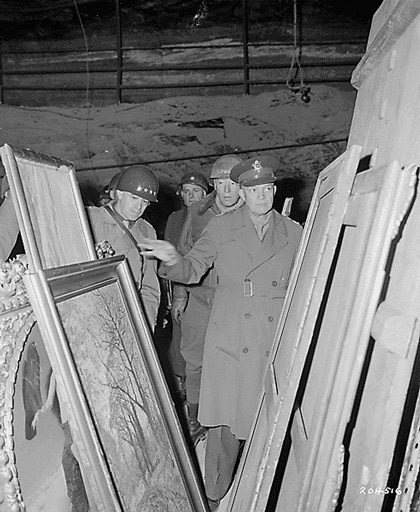Today is the 75th anniversary of D-Day, the day that marked the beginning of the end for the Allies pushing back the darkness of Hitler, the Nazis, and the Holocaust. Today was a reminder of America’s legacy of fighting at great national and individual expense against evil and injustice, a legacy that I am grateful for and inspired by.

I was also reminded of that legacy when my teacher-artist wife and I recently watched the movie “Woman in Gold” (2015). The movie tells the story of affluent, Jewish Maria Altmann (Helen Mirren) and her husband leaving everything to flee Nazi-controlled Austria and then her late-in-life lawsuit against the Austrian government for her family painting, the “Austrian Mona Lisa,” the “Painting of Adele-Bloch Bauer I” by Gustav Klimt. Maria secures the help of young, inexperienced Austrian-American lawyer, Randy Schoenberg (Ryan Reynolds), who took the underdog case all the way to the U.S. Supreme Court and won.

German plunder machine
The movie is a reminder of the great loss that so many faced during World War II: the loss of the lives of family, friends, and loved ones by the German war machine, but also the loss of businesses, personal property, and family heirlooms through an equally devastating German plunder machine.

In WWII, Nazi Germany looted each country they invaded, handpicking art for the Führer and top brass of Nazi leadership. Hitler was himself an unsuccessful artist who was denied admission into the Vienna Academy of Fine Arts. Nonetheless, he considered himself a connoisseur of the arts and had grand plans to setup an art and cultural capital of the Third Reich in his hometown of Linz, Austria. The looting was so pervasive that nearly 20% of European art had been looted by the Nazi’s during their European conquest. But the looting didn’t stop there even after the German army was in decline.

The Soviet’s policy of plunder
As the German defeat neared, the Soviet Union, a member of the Allied Forces, also engaged in systematic looting of art and property during their march towards Berlin. The Soviet losses had been tremendous at the hands of the German military, so the Soviets believed that the taking of property were reparations for the damage and looting done by the Germans.

To illustrate the prevalence of subsequent Soviet looting, one of the most iconic Soviet images of WWII shows a victorious soldier hoisting a Soviet flag over the Reichstag after the Battle of Berlin. A nearby soldier supporting the flag bearer is seen wearing two watches. The natural conclusion is that one of the watches had been looted, though the Soviet explanations evolved from the second watch being a compass to eventually being doctored out of the image entirely.
It’s been reported that thousands of pieces of art, including works by Monet, Degas, Renoir, and others European masters, have been kept in hideaways in Moscow, Leningrad, Kiev, and other cities since WWII.
Just seven years after the USSR collapsed, the newly formed Russian Federation (Russia) came to a decision point on what to do with the contested artwork. Instead, Russia controversially doubled-down on their WWII policy of plunder and passed a law in 1998 allowing Russian institutions to keep art works looted during the war.
America was different
America took a different path: a path of virtue and justice. In what could have easily been a winner-take-all conquest and land grab, America took no land except to bury our fallen soldiers and sailors. 172.5 acres on a bluff overlooking Omaha Beach was taken to establish the Normandy American Cemetery and Memorial in remembrance of D-Day and the American losses during WWII.

And, while the Germans and Soviets were plundering artwork and valuable property, the U.S. government set in motion the identification, recovery, and restitution of looted assets. The presidentially-appointed Roberts Commission, chaired by Supreme Court Justice Owen Roberts, ran from 1943 to 1946, and worked with the US military’s Monuments, Fine Arts, and Archives (MFAA) unit of the US Army – as seen in the movie “Monument Men” (2014) – to protect, inventory, and restitute works of Nazi-appropriated art. At great expense of time and resources, the U.S. played a significant role in the restoration of much of the looted art that the Nazis took.

While taking paintings was a very small part of the wrong that the Nazis and Soviets did during WWII, so bringing restitution to artwork was a very small part of the good America did during this time. But, with precious lives and resources on the line, committing to the restitution of European art must have been a difficult decision.
I believe there is a lesson for those of us sitting under the shade of that legacy 75 years later. Doing the right thing and pursuing justice is hardly ever easy and so often comes at great personal expense even in small matters. But it’s what Americans do, and it is what has made our country a shining beacon of light in the world.
Question: Is there anything you’ve seen the U.S. government stand up for or stand up against in the world that you’re proud of?

One response to “Even in art America fought for justice in WWII”
This Doc: “Excellent article and can’t wait to discuss in more detail at the beach. My Dad served in the South Pacific on an aircraft carrier and the burials of our men were at sea.”